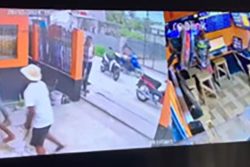Dear Editor,
I previously wrote that the production of the serious crimes figures by the police to indicate that there is a decrease in serious crime is meaningless when the perception is that crime is high and that citizens are living in perpetual fear of crime. The stats do not tell the full story. However, recent statements by the Minister of Home Affairs and the acting Com-missioner of Police about the reduction of serious crimes have caused me to put back my finger on the keyboard.
At the recent Police Anniversary Award Ceremony, the Acting Commissioner of Police Clifton Hicken who is squatting in that position boasted, “We are currently experiencing a 18.9% reduction in serious crimes, thanks to the active presence of 361 community policing groups across the regional divisions, intelligence-led policing methods such as crime mapping and predictive analysis and the use of drones, body cameras, and CCTV for real time surveillance and hotspot management.” Speaking about the crime statistics Minister of Home Affairs Robeson Benn gleefully posited, “ I think that it is almost a third or fourth year running that we reduced it by 20% each year. We have been able to get good results.” The statements by the Minister and the acting Commissioner lack substance. They need real disaggregation. It is a horrible attempt by the man who is responsible for policy in the GPF and the other one who is in charge of operations to give the public the impression that the police are efficient and effective and that they are on top of crime in the country when the situation is the opposite. In a surprise disclosure, the supreme legal influencer of the Govern-ment of Guyana, Attorney General Anil Nandlall at his recent weekly television programme ISSUES IN THE NEWS, opined, “The Government is not comfortable with the level of crime and violence in the society and that is no secret. We have repeatedly accepted the fact that we are assiduously working to address the situation.” The reality is that serious crime is generally out of control and that citizens are living in constant fear of crime.
Here is the list of what the police considered and analysed as serious crimes: Murder; Robbery, Robbery where guns were used; Robbery where other weapons were used; Robbery with aggravation; Robbery with violence; Larceny from the person; Burglary; Break and enter and larceny; Kidnapping and Rape. This list of serious crimes used by the police to measure how well they are performing was first introduced by Commissioner Laurie Lewis over three decades ago. He identified 11 serious crimes that were analysed on a monthly and yearly basis
This is the same list presently being used by the police although crime and criminal activities have evolved over the years. It does not cater for manslaughter, drug trafficking, trafficking in person, gold smuggling, unlawful possession of firearms and ammunition, arson, offences under the Sexual Offences Act apart from rape, money laundering, white collar crimes, cyber crimes and other serious offences. Although there is an overall reported decrease in serious crimes, there is the possibility of the increase of some of the crimes under review. What about the ‘ dark figures’ in crimes, that is, crimes not reported to the police for diverse reasons including the belief of victims that the police will be unable to solve the crimes? The possibility of ‘ ghosting ‘ that is, falsifying patrol logs to ‘make numbers come out right for them’ cannot be overlooked.
Wayne W. Benett and Karen H. Hess in their book ‘Management and Supervision in Law Enforcement’ explained that many people tend to use crime rates, number of arrests and clearance rates to measure how the police are doing. They suggest that such measures have several problems: low crime rates do not necessarily mean that a police agency is efficient and effective; a high arrest rate does not necessarily show that the police are doing a good job; a high ratio of police officers to citizens does not necessarily mean high-quality police service; responding quickly to calls for service does not necessarily indicate that a police agency is efficient.
Kramer and Fields (2000) summarises the problem aptly, “Traditional measures such as Uniform Crime Reports ….arrests and tickets tabulate only events. They do not measure whether or not the activities were completed effectively or efficiently, and they don’t describe what impact the activities had on the community.” They explained that rather than looking at crime rates, number of arrests, and response time, evaluation should assess whether or not the police are fulfilling their responsibilities to the communities they swore to serve and protect.
When evaluating the effectiveness and efficiency of the Guyana Police Force, the police must consider what citizens want and expect from their protector. Most citizens want to live in safe, orderly neighbourhoods. The police are considered effective when they produce the perception that crime is under control. Reducing the fear of crime is a very important measure. One way to assess citizen approval or disapproval is through citizens surveys, which can measure trends and provide positive and negative feedback on the public’s impression of law enforcement. Community surveys can also be key in establishing communication. It might also set organisational goals and priorities, identify department strengths and weaknesses, identify areas of improvement and needed training and influence motivation of ranks.
May God bless the Guyana Police Force.
Yours faithfully,
Clinton Conway
Assistant Commissioner of Police
(Retired)




